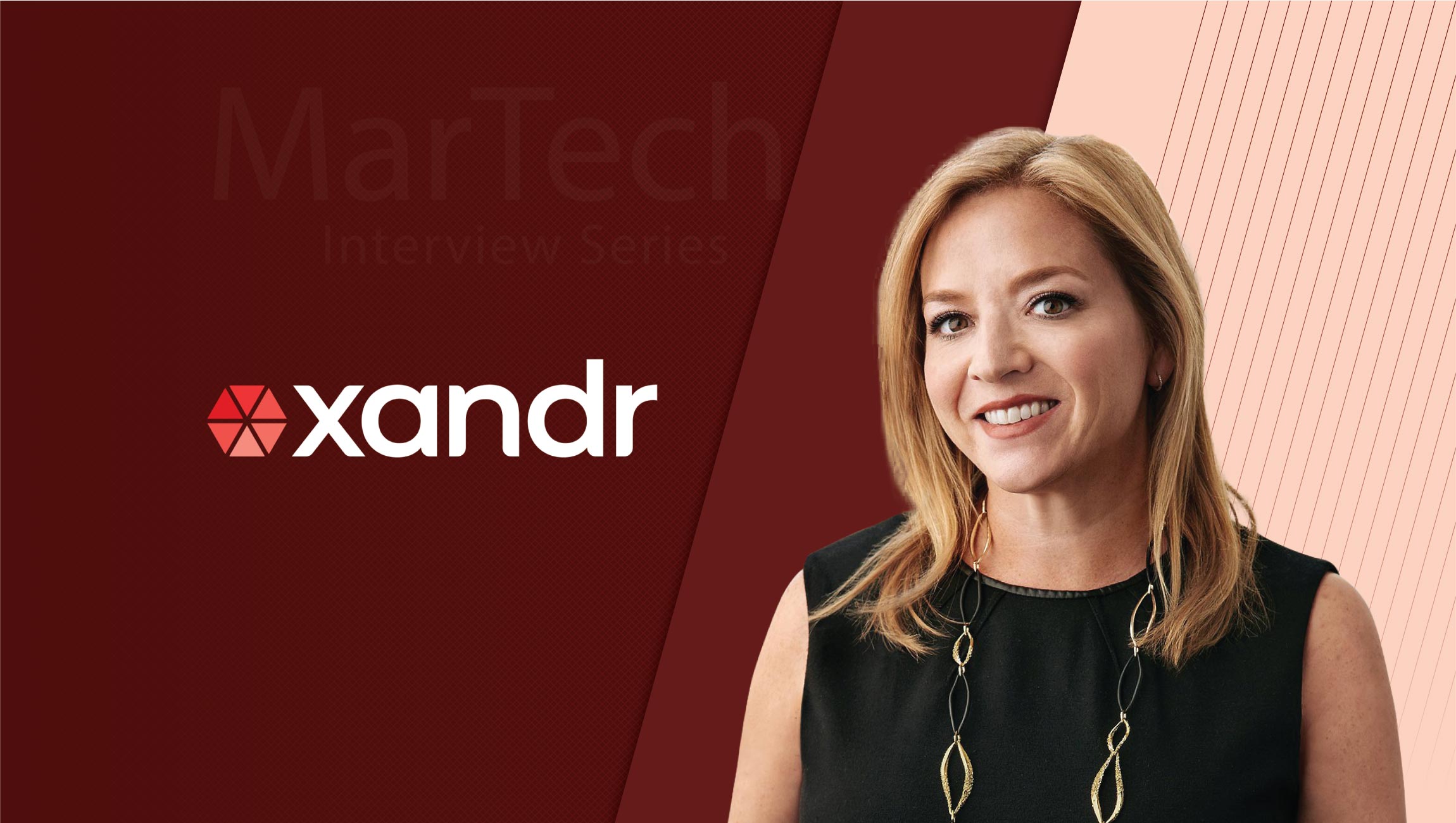“Access to first-party data is going to be critical for the success of the digital advertising ecosystem.”
[/vc_wp_text]
Hi Amy, please tell us about your role/team you handle at Xandr. What inspired you to join Xandr?
As the Executive Vice President of Operations & Services, my role at Xandr puts me in the center of Xandr’s business by working with and supporting our entire Sales organization and making sure we support every single client that buys our media and uses our platform. As we introduce new products into the Advertising marketplace, it’s my job to ensure our teams are not only knowledgeable but can continue to deliver best in class service to our customers.
I have been living and breathing advertising sales and operations for the past twenty five years. Prior to Xandr I was at DirecTV where I launched and operationalized their ad sales business. In 2015 we were acquired by AT&T, so I was an early member of AT&T’s addressable TV advertising business. When AT&T was preparing to launch their advertising company Xandr, I was brought in to lead the sales planning and operations division.
Television content consumption and advertising has evolved over the years and I have been lucky to have a front row seat to that change. TV ads were once run primarily to impact top of funnel metrics, and there was no infrastructure in place to personalize the viewers’ experience. There was often limited measurement or feedback on performance available, so it was difficult to know where the return was.
Because of Xandr’s first-party data and consumer relationships, we have a really unique opportunity to drive the adoption of data-driven TV buying and reinvent the way TV advertising is bought, sold and optimized. That’s what keeps me coming to work every day.
You have led Ad Sales and Revenue generation teams for some of the leading TV Adtech companies. How have your go-to markets and customer profiles evolved in the last 3 years?
There has been a massive amount of growth and interest in addressable advertising. It went from a test tactic to an always-on item for our clients. Brands and agencies are expressing greater interest in the targeting capabilities of television, but at the same time they are looking for reach and better measurement.
It’s an exciting time to be in advertising industry. The holy grail of television advertising has always been the ability to deliver a personalized ad at scale on the living room screen, and we’ve made that a reality.
What factors have led to this disruption in your marketplaces?
It’s no secret that traditional linear television advertising has been declining as marketers have been increasing their investments in digital. Marketers care more about measurement and ROI than ever, and we’re past the days of a CMO just making one big splashy television ad campaign and being satisfied that they secured a spot during the Super Bowl.
Now that the advancements in television advertising technology have caught up to the wants and needs of marketers, we’re seeing increased double digit growth in our advanced advertising products.
At Xandr, how do you combine all the Sales efforts, research and analytics, product marketing and back-end reporting?
Having a successful go-to-market strategy and approach requires tight alignment across multiple functions between Sales, Poperations and Marketing. We rely on each of these teams to be experts in their fields, bringing bright, innovative ideas and approaches to the marketplace and client engagements.
Operations works hard to develop simple and streamlined processes to best support our Sales team as well as surfacing the right information to Marketing. It ultimately comes down to the back end report and analytics that delivers insights and learnings back to the advertiser for each and every campaign. Those invaluable insights are brought to the advertiser with the sales team and includes a recommendation for the next campaign.
Tech Insights on Ad Sales
What does your Sixth Sense say about the future of the “Addressable TV Advertising” industry?
Consumers have more choices than ever to access TV content, and that’s only going to increase as more Ad-supported Video On Demand (AVOD) services are launched. There’s a lot of discussion about market saturation and who is going to win the “streaming wars”, but the fact is that there is a limit to how many services a consumer can both budget and also have time for. This is a young market and there is room for everyone. One of the biggest issues with addressable TV advertising was scale, so we’re finally solving for that.
The future of addressable TV advertising is strong. Advertisers are learning to navigate the increased complexity of a much more fragmented landscape. On one hand demand has always outweighed supply for video, so this should be a boon to advertisers. On the other, advertisers will have to stay on top of the changing landscape, and understand how they can integrate multiple streaming services, audiences, ad formats and devices into their campaigns.
Today, addressable TV advertising is a modest, but growing portion of video ad spending. The benefits, including true cross-screen reach and the ability to incorporate addressable advertising into a consumer’s exposure journey, as well as cost and transparency (to name just a few) are too much to ignore.
Together with OTT, CTV and Addressable TV markets, what other emerging technologies are you keenly following?
The impending death of the cookie can’t be ignored. The cookie is the infrastructure of the internet and the foundation for so much of the digital advertising ecosystem. Ultimately, marketers are going to have to re-evaluate their KPIs, look beyond vanity metrics like CTR and completion rate and make investments in alternatives to cookie-based technology.
Second, with the growth of addressable TV, there is a lot of opportunity around developing unified metrics and measurement practices. As addressable TV continues to penetrate the market, aligning the metrics that media is being bought and sold on across multiple platforms is going to be important from a standards perspective.
What is your secret sauce to stay on top of your market? How do you leverage Sales and Marketing technologies to gain instant recall-value in your customer’s mind?
Activating CRM data for targeting, attribution, and optimization is one of the most effective tools marketers have to drive performance. Xandr has built one of the most sophisticated infrastructures for enabling this for addressable TV and premium digital video. The secret sauce there is our own AT&T data and our 170 million consumer connections. The data enables us to match and build models for our clients with market leading fidelity driving market leading performance.
Hear it from the pro: How to use customer feedback to build a better product? How often do you provide feedback to your Product Development and Marketing teams?
Customer feedback is critical when evaluating how to deliver the best in class service that we strive for every day. I manage a team of over 350 employees that are on the front lines working with all of our customers, and communication and teamwork is key.
Services is the central point between Sales, Research and Analytics, and Product Marketing to drive operational success across Xandr’s business units. I have to stay in constant communication in order to make strategic and informed business decisions and drive success with our clients across all our products.
With Google Chrome deciding to keep out third-party cookies, what impact would it have on these programmatic media buying models? How will Xandr prepare to adapt to the post-cookie reality?
Because Xandr has over 170 million direct to consumer relationships across TV, mobile and broadband, and operates on both the supply-side and demand-side, we are uniquely positioned to navigate an advertising market that evolves beyond the cookie.
Access to first-party data is going to be critical for the success of the digital advertising ecosystem. The future of the cookie is looking grim, and marketers are going to be looking for new ways to target the right audiences. Identity based solutions are going to be the path forward.
Is AdTech + Artificial Intelligence the way forward for the AdTech companies? What about other fast-growing technologies such as RPA, Blockchain and Automated Machine Learning?
We are always looking for new technologies to help disrupt and evolve our operations, whether that means streamlining, automating, or outsourcing. A few examples include our product teams leveraging algorithms to improve our optimization engines and client operations working with an automated ML vendor for contracts.
I don’t think there is one technology or solution that will be the AdTech silver bullet. That’s one of the most interesting things about ad tech, it’s always changing, so we are always learning.
Snap Shot
An advice to young Sales professionals in the Advertising tech industry –
Be confident and make sure your voice is heard. Your opinion is important and good leaders always want to hear different perspectives.
One superwoman character/iconic person that you feel most-connected to—
Oprah; she is a super woman!
Tag a person in the industry whose answers you would like to read here:
Chris Faw.
Thank you, Amy! That was fun and hope to see you back on MarTech Series soon.
Amy is a female exec that comes from the DirecTV side of the business and has been in advertising for about 25 years. She ran programming and distribution for DirecTV and operationalized both the Game Show Network and DirectTV for national advertisers. She leads Xandr’s US operations for media and platform. Her claim to fame is that she started the DIRECTV Ad Sales business in 1995 where she sold and operationalized the first 30 second commercial to air in the 2 minutes of time DIRECTV gets from its programming partners.
Amy unified the legacy Xandr Media & AppNexus services teams and drove operational success and processes while continuing to drive yield optimization which resulted in sizeable revenue upside for Xandr in 2019. In Q4 of 2019, Xandr total revenues were $607 million, up 7.2% year over year due to growth in advertising business.
As an industry leader in advanced TV and one of Xandr’s top female executives, Amy acts as the nucleus that combines all the sales efforts, research and analytics, product marketing and back-end reportin. Amy and her team support Xandr’s sales teams and evangelize the unique data, measurement and attribution capabilities, underscoring AT&T’s presence as a one-stop shop for premium TV and video inventory.
Xander is a a collective with a common purpose: make advertising matter to brands and consumers alike. Leveraging the spirit of innovation that began with Alexander Graham Bell more than 140 years ago and has continued on as a part of AT&T’s legacy, we are uniquely positioned to move the industry forward.
With one of the world’s largest collections of digital, film and TV properties*, we provide a premium option for advertisers and publishers looking to reach specific audiences at scale in premium and brand-safe environments.












